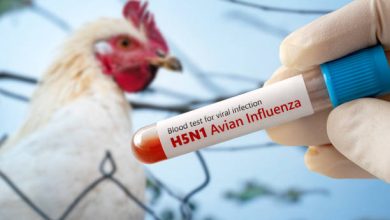6 Science-backed Ways to Prevent Prostate Cancer
Try these simple lifestyle changes to help reduce your risk of developing prostate cancer.
In honor of National Prostate Cancer Awareness Month, the African American Wellness Project is teaming up with Linkwell Health, the premier digital content marketing and consumer experience technology company in healthcare, to help spread the word about prostate cancer risks, treatment, and prevention in the African American community.
Maybe you’ve heard it said that if every man lives long enough, he’ll develop prostate cancer. Research suggests that’s true, but you’d have to live a long time to have a guaranteed diagnosis — 253 years, according to findings in the journal Current Oncology.
Still, getting older is a top risk factor for the disease. Most cases — 60% — occur in men over 65. While we can’t stop time from marching on, we do have a lot more control over other risk factors. Keep reading to learn what they are and what you can do to lower your risk of developing prostate cancer.
Step 1: Eat smart
Putting the right foods on your plate not only can cut your likelihood of developing prostate cancer, but it can also slow the disease’s progression if you already have it. So what are the right foods?
“Eating an antioxidant-rich diet is key,” says Dawud Lankford, M.D. He’sa urology specialist with a private practice in Oakland, California. Antioxidants are natural compounds, such as vitamins C and E. They help protect your cells from free radicals that can play a role in cancer and other diseases. They’re found mostly in fruits and vegetables.
Also important: long-chain omega-3 fatty acids, aka the “good” fats found in fish. Omega-3s are linked with a lower risk of developing advanced prostate cancer, according to the Prostate Cancer Foundation. On the other hand, saturated fat — found in animal products such as beef, butter, and full-fat dairy — can raise your risk of developing cancer.
Does that mean you have to swear off meat and cheese and live on salad to keep your prostate healthy? No. Instead, think of it as adding more prostate-friendly foods to your diet each day and cutting back on those that can harm your prostate. So aim to eat more:
- Cruciferous veggies, such as broccoli, cauliflower, collard greens, and cabbage.
- Berries
- Fish
- Cooked tomatoes, such as spaghetti sauce and tomato paste, and juice. They’re high in lycopene, a powerful antioxidant. Cooking tomatoes makes it easier for our bodies to absorb lycopene.
- Lean poultry, such as skinless chicken breast
- Beans, such as soybeans and black beans
- Nuts
And try to eat less:
- Red meat
- Full-fat dairy products, such as milk and cheese
- Charred meat, which may produce a chemical compound that causes cancer
- Fried foods
- Sugary drinks
Step 2: Keep moving
You know that exercise is good for a lot of things. So perhaps it’s no surprise that lowering your risk of prostate cancer is on the list of benefits.
“The immune system prevents cancer. So doing things to boost your immune system is what will prevent cancer,” Dr. Lankford says. “That includes getting enough exercise.”
In a 2021 JAMA Oncology study, researchers found that high-intensity exercise led to lower levels of prostate-specific antigen (PSA). This matters because as your PSA levels rise, so does your risk for prostate cancer. The researchers also found that more exercise was linked with slower-growing disease in prostate cancer patients.
What kind of exercise is best? Any kind that gets your heart beating up and makes you sweat. Aim for 2.5 to five hours of vigorous aerobic activity each week — that’s as little as about 22 to 45 minutes a day. Try:
- Walking briskly (add in bursts of jogging if you can)
- Running
- Fast swimming
- Fast bicycling
Step 3: Watch your weight
Obesity — defined as having a body mass index (BMI) of 30 or higher — can pose a triple threat when it comes to prostate cancer. Men with obesity may have a higher risk of prostate cancer than those with BMIs in the “normal” range, according to the Mayo Clinic. The disease also progresses faster in men who have obesity. And obesity is linked with a higher chance of dying from prostate cancer.
For all these reasons, maintaining a healthy weight is key to lowering your prostate cancer risk and boosting your overall health. Following steps 1 and 2 above can help you reach your healthy-weight goals.
Step 4: Kick (cigarette) butts
Your lungs aren’t the only things that suffer if you smoke. The habit affects every cell in your body — including your prostate cells.
One research review found that current smokers had a higher risk of fatal prostate cancer than former smokers. And the more they smoked, the higher their risk of death from prostate cancer: The heaviest smokers had a 24% to 30% greater risk of death.
Here’s the key takeaway from that study: Participants who were former smokers had a lower risk of prostate cancer. Which means you, too, can reduce your risk by kicking the habit. If you’ve been looking for a truly motivating reason to quit, you just found it.
Step 5: Get into green tea
Why green tea? Men who drank more than seven cups of it a day had a significantly lower risk of developing prostate cancer in one Medicine meta-analysis. Scientists think it has something to do with a type of antioxidant called polyphenols — good-for-you micronutrients that occur naturally in plants.
If you decide to load up on green tea, make sure not to stir in too much sugar. (Some people do because they find the flavor a bit bitter.) A bit of honey can help bring out the natural sweetness in the brew.
Step 6: Cut back on alcohol
If a nightly nightcap is your thing, consider making it a less regular habit. In one study, men who were lifetime drinkers, or who drank seven or more alcohol drinks per week for decades, were three times as likely to develop high-grade prostate cancer. And prostate cancer patients who skipped alcohol altogether were much less likely to die from the disease than those who had two or more drinks a day, according to a second study from Cancer Epidemiology.
The bottom line
“There’s no magic pill to prevent prostate cancer,” Dr. Lankford says. “That’s wishful thinking. Instead, it’s a combination of factors. That’s why optimizing your health is the most important thing you can do. That’s what we should all be doing to prevent any disease.”
Sources:
Pollock PA, MRes, Ludgate A, et al. “In 2124, half of all men can count on developing prostate cancer.” Current Oncology, February 2015; 22(1): 10-12.
Mahal BA, Berman RA, Taplin ME, et al. “Prostate cancer-specific mortality across Gleason scores in Black vs. Nonblack men.” JAMA Network, December 18, 2018; 320(23): 2479-2481.
“Antioxidants.” Mayo Clinic, March 1, 2022, available at https://www.mayoclinic.org/healthy-lifestyle/nutrition-and-healthy-eating/multimedia/antioxidants/sls-20076428. Accessed August 1, 2022.
“Prostate cancer diet.” Prostate Cancer Foundation, available at https://www.pcf.org/patient-resources/living-prostate-cancer/prostate-cancer-diet/?utm_source=google_cpc&utm_medium=ad_grant&utm_campaign=awareness_survivor_wellness&gclid=Cj0KCQjwhqaVBhCxARIsAHK1tiP7aNeEeK4GJvand3nZ-KNTDuf7pemjnD0Y4MC7Ttfa9UukQqBlBbcaAuthEALw_wcB. Accessed August 1, 2022.
Bacanli M, Basaran N and Basaran AA. “Lycopene: Is it beneficial to human health as an antioxidant?” Turkish Journal of Pharmaceutical Sciences, December 2017; 14(3): 311-318.
“Five foods to protect your prostate.” Prostate Cancer Foundation, available at https://www.pcf.org/c/five-foods-to-protect-your-prostate/. Accessed August 1, 2022.
“Prostate cancer prevention.” Johns Hopkins Medicine, available at https://www.hopkinsmedicine.org/health/conditions-and-diseases/prostate-cancer/prostate-cancer-prevention. Accessed August 1, 2022.
Kang DW, Fairey AS, Boulé NG, et al. “Fitness and biochemical progression in men with localized prostate cancer under active surveillance.” JAMA Oncology, 2021; 7(10): 1487-1495.
“Physical activity and cancer.” National Cancer Institute, February 10, 2020, available at https://www.cancer.gov/about-cancer/causes-prevention/risk/obesity/physical-activity-fact-sheet#:~:text=150%20to%20300%20minutes%20of,of%20each%20intensity%20each%20week. Accessed August 1, 2022.
“Exercise for prostate cancer.” Prostate Cancer Foundation, available at https://www.pcf.org/patient-resources/living-prostate-cancer/exercise-prostate-cancer/#:~:text=Several%20studies%20have%20shown%20that,to%20add%20bouts%20of%20jogging. Accessed August 1, 2022.
“Prostate cancer prevention: Ways to reduce your risk.” Mayo Clinic, September 24, 2020, available at https://www.mayoclinic.org/diseases-conditions/prostate-cancer/in-depth/prostate-cancer-prevention/art-20045641. Accessed August 1, 2022.
Wilson RL, Taaffe DR, Newton RU, et al. “Obesity and prostate cancer: A narrative review.” Critical Reviews in Oncology/Hematology, January 2022; 169: 103543.
Huncharek M, Haddock KS, Reid R, et al. “Smoking as a risk factor for prostate cancer: A meta-analysis of 24 prospective cohort studies.” American Journal of Public Health, April 2010; 100(4): 693-701.
Guo Y, Zhi F, Chen P, et al. “Green tea and the risk of prostate cancer.” Medicine (Baltimore), March 2017; 96(13): e6426.
“Green Tea.” Mount Sanai, available at https://www.mountsinai.org/health-library/herb/green-tea#:~:text=Early%20clinical%20studies%20suggest%20that,and%20stop%20them%20from%20growing. Accessed August 1, 2022.
Michal J, Howard LE, Markt SC, et al. “Early-life alcohol intake and high-grade prostate cancer: Results from an equal-access, racially diverse biopsy cohort.” Cancer Prevention Research, October 2018; 11(10): 621-628.
Farris MS, Courneya KS, Kopciuk KA, et al. “Post-diagnosis alcohol intake and prostate cancer survival: A population-based cohort study.” International Journal of Cancer, February 13, 2018; 143(2): 253-262.




